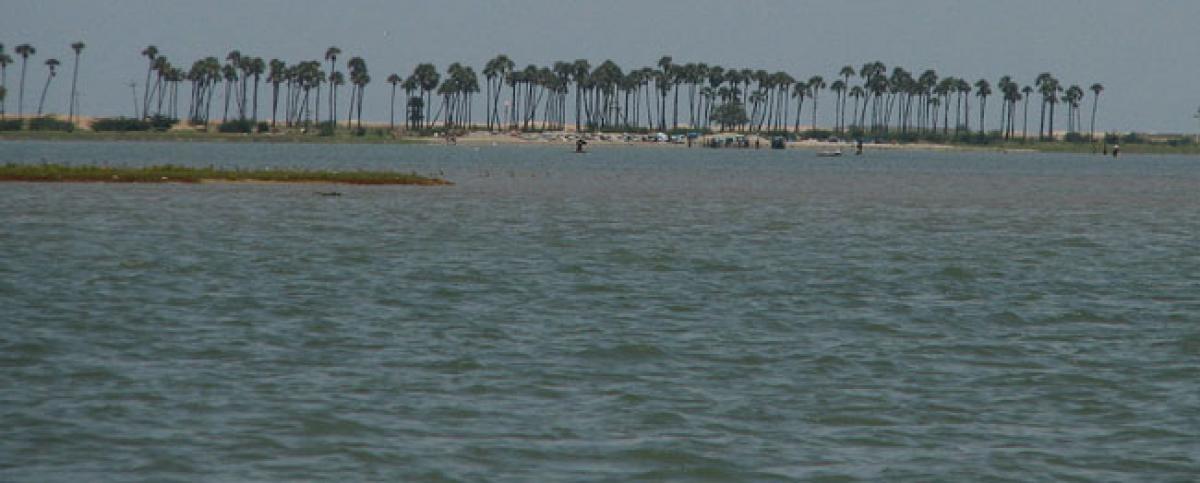Live
- SUCI to contest for Tirupati Assembly
- Hyderabad: Congress chants Ram, Ram; steals thunder from BJP
- VIT Engineering Entrance Exam (VITEEE) from today
- BJP demands removal of ‘biased’, ‘incompetent’ officers
- Hyderabad: 20 Congress MLAs in touch with BRS, claims KCR
- Prof Vani takes charge as Dean in SPMVV
- My Dear Donga: trailer get grand launched
- Supreme Court reserves verdict
- Poll battle begins
- Phase 1 polls in 102 seats across 21 states today
Just In

Problems continue to persist in Pulicatlagoon, the second largest brackish water lagoon in India, due to lax administration which has been only assuring to open the mouths of lake without taking concrete steps As a result, salinity levels have been increasing which affect the living organisms in the lake
Nellore: Problems continue to persist in Pulicatlagoon, the second largest brackish water lagoon in India, due to lax administration which has been only assuring to open the mouths of lake without taking concrete steps. As a result, salinity levels have been increasing which affect the living organisms in the lake.
Salinity levels in Pulicatlake are normally high during summer that results in decrease in the quantum of fish. Lack of water flow into the lake due to closed sea mouths and mixing of contaminated water from nearby industriesare also adding woes.
The state government had announced Rs. 48 crorefor opening sea mouths in January this year. Still, there is no progress in the works. The 18,440-hectare wide Pulicat lagoon, which runs parallel to the Bay of Bengal across the Tamil Nadu-AP border, is the second largest brackish water lagoon in the country.
It has an area of 720 sq. km, of which 84 per cent falls in Andhra Pradesh and the remaining 16 per cent in Tamil Nadu. The lagoon is about 60 km in length and its breadthvaries from 0.2 km to 17.5 km.
Basically, water flow plays pivotal role in the existence of biodiversity of the lake and closed sea mouths are giving sleepless nights to the local fishermen who rely on fishing for their livelihood. In future, there would be huge impact on influx of winged birds which visit the lake from across the globe if the same trend continues, say scientists.
Pulicat has three major openings into the Bay of Bengal, the largest being at the southern end of the Sriharikota Island, another at the northern tip of the Sriharikota Island and thethird at the extreme northern part close to Dugarajapatnam in Vakadumandal. The Buckingham Canal traverses in north to south direction along the eastern edge of Pulicat and along Sriharikota Island.
The rivers Swarnamukhi and Kalangi in the northern part and the Arani and Moolthangal in the southern part drain into the lake during the monsoon season, causing an increasein water levels and a decreasing salinity.
Pulicat has 20 islands, the largest being Sriharikota Island and the others are Pernadu, Irrukkam andVenadu. Due to less rainfall this year, the inflows into lake have been reduced and salinity levels increased. The seawater enters the lake during high tides in Bay of Bengal through two gateways at Pamanjeri and Vepanjeri. The lake empties its water into the Bay of Bengal, through its mouths.
“Due to the closing of the mouth during the summer causes major problems for the biodiversity of the lake. Water flows have become scanty due to closed mouths and the drought conditions are also making the situation worse,” said a senior scientist from a Chennai based government organisation.
During monsoon when freshwater inflow is greater, this lake will be like a positive estuary.But during summer, the condition is reversed. Due to high evaporationand precipitation, it becomes dried up estuary. The water temperature of the lake varies from 25 deg C to 32.6 deg C. ``Most species in the environment live under stress due to low or high salinity,’’official added.

© 2024 Hyderabad Media House Limited/The Hans India. All rights reserved. Powered by hocalwire.com







